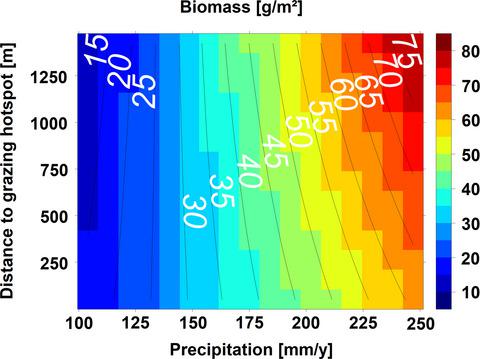当前位置:
X-MOL 学术
›
Appl. Veg. Sci.
›
论文详情
Our official English website, www.x-mol.net, welcomes your
feedback! (Note: you will need to create a separate account there.)
Interactions between species richness, herbivory and precipitation affect standing biomass in Mongolian rangelands
Applied Vegetation Science ( IF 2.0 ) Pub Date : 2021-04-04 , DOI: 10.1111/avsc.12581 Julian Ahlborn 1, 2, 3 , Karsten Wesche 3, 4, 5 , Birgit Lang 6 , Munkhzul Oyunbileg 7 , Batlai Oyuntsetseg 8 , Christine Römermann 5, 6 , Neil French Collier 9 , Henrik von Wehrden 2
Applied Vegetation Science ( IF 2.0 ) Pub Date : 2021-04-04 , DOI: 10.1111/avsc.12581 Julian Ahlborn 1, 2, 3 , Karsten Wesche 3, 4, 5 , Birgit Lang 6 , Munkhzul Oyunbileg 7 , Batlai Oyuntsetseg 8 , Christine Römermann 5, 6 , Neil French Collier 9 , Henrik von Wehrden 2
Affiliation

|
Livestock management in rangelands depends on the production of plant biomass. Biomass production is driven by the temporal and spatial variability in precipitation, but our understanding of how precipitation variability mediates grazing effects on biomass production is still fragmented. Along a 600‐km precipitation gradient we extracted biomass data to ask the questions: (a) what are the effects of grazing intensity on biomass production; (b) does grazing intensity interact with plant species richness to affect biomass production; and (c) how do plant functional groups respond to grazing and precipitation?
中文翻译:

物种丰富度,草食性和降水之间的相互作用影响蒙古牧场的站立生物量
牧场的牲畜管理取决于植物生物量的生产。生物量生产受降水的时空变化驱动,但是我们对降水变化如何介导放牧对生物量生产的影响的理解仍然是零碎的。沿着600 km的降水梯度,我们提取了生物量数据以提出以下问题:(a)放牧强度对生物量生产有什么影响;(b)放牧强度是否与植物物种丰富度相互作用,从而影响生物量的生产;(c)植物官能团如何响应放牧和降水?
更新日期:2021-05-06
中文翻译:

物种丰富度,草食性和降水之间的相互作用影响蒙古牧场的站立生物量
牧场的牲畜管理取决于植物生物量的生产。生物量生产受降水的时空变化驱动,但是我们对降水变化如何介导放牧对生物量生产的影响的理解仍然是零碎的。沿着600 km的降水梯度,我们提取了生物量数据以提出以下问题:(a)放牧强度对生物量生产有什么影响;(b)放牧强度是否与植物物种丰富度相互作用,从而影响生物量的生产;(c)植物官能团如何响应放牧和降水?











































 京公网安备 11010802027423号
京公网安备 11010802027423号